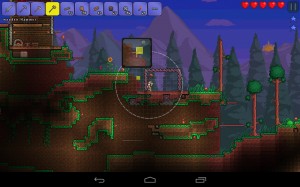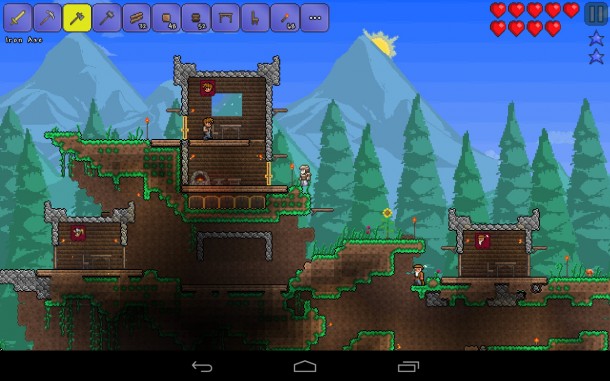Terraria, the spiritual successor to the block-bashing game Minecraft, has been out for a little more than a year now on PC and a few months on consoles. This side-scrolling 16-bit game has won many a gamer’s heart by offering retro-style graphics combined with a deep crafting system. Terraria continues to gain popularity so it’s no wonder that it’s now available on mobile, but with so many platforms to play this game on – is it worth buying yet another edition?
Bringing it Back Old School
At first glance, Terraria seems to be a lackluster indie game with a clunky, confusing interface and a list of crafting options a mile wide. Especially for you Minecraft transplants, you’ll initially find the flat, side-scrolling perspective a bit off-putting after countless hours having been spent in an immersive, 3D environment. Take some time to adjust your lenses, however, and you’ll discover a game that’s both deep and almost endlessly entertaining.
Terraria, like Minecraft, almost assumes that you’ll learn the vast majority of its intricacies via the Terraria wiki. Here, you’ll find all the info you’ll ever need when it comes to the different biomes, crafting recipes, statue traits, and boss mechanics. Since this is a review, however, I’ll give you a short run-down just in case you’re not already familiar. For those of you who have already played Terraria on other platforms and you just want to know if $4.99 is worth it for the mobile version, you may want to skip ahead a couple sections.
A New Beginning
After a short character customization window, you’ll be dropped smack in the middle of a forest with nothing but some basic copper tools and the Guide NPC to help you answer simple questions. In a short while, the sun will disappear giving way to the night – a time of dangerous zombies and floating eyes – so you’ll need to prepare for the long road ahead. Wood and gels (obtained from slimes) will be essential for mining as you’ll want a) platforms to safely navigate tunnels and b) torches to light up the darkness. In Terraria, you’ll need to create crafting tables in order to craft new items, and these tables come in many different varieties – tables, forges, anvils, looms, sawmills, etc. Each type of table allows you to craft a specific set of items when standing in front of it.
While wood and slimes can be found above-ground, the vast majority of raw materials exist below the earth. My tendency in games like Terraria and Minecraft is to immediately start harvesting resources (copper, iron, silver, and gold ore) before building a home, using the safety of my tunnels as a barrier against creatures of the night. Going after ores first-thing will let you upgrade your armor, weapons, and tools a bit before starting on a house. However, you can always jump the gun and build a basic wood and dirt home straight out of the gates without too much effort.
A Room With A View
A bit on homes: In Minecraft, a home is simply a place to stay where you can pass the night by without the worry of being attacked in your sleep. A home in Terraria also provides similar safety while also allowing NPCs to move in. Each NPC offers unique services once they have adequate housing, usually in the form of selling items. An NPC “room” has specific requirements, so see the wiki for details.
There are different biomes in Terraria – forest, jungle, desert, ocean, and corruption – each featuring new creatures and resource types. As you dig down beneath the surface you’ll also travel through distinct “layers” (similar to biomes) with increasingly tough mobs and rare treasures. If you explore deep enough, you’ll find heart crystals that permanently add to your life total and chests with rare items inside! While exploration and crafting take up the bulk of your time in Terraria, you’ll also end up triggering the odd boss encounter.
Prepare Yourself
Unlike Minecraft, there are several unique bosses in Terraria that will spawn once certain requirements have been met (again, see wiki). It’s wise to read-up on these bosses early on as unleashing one into the world when unprepared could land you in a very frustrating situation. The first boss, the Eye of Cthulu, appears once you’ve hit 10 hearts (200 life), have housed 3 NPCs, or have at least 10 defense, and he’ll show up every night to harass you until he’s defeated.
Dig, harvest, collect, craft, create a village and slay your enemies – those are the basics of Terraria. Now, let’s get into some specifics in terms of mobile vs. the other platforms. The mobile version scales down the map to a “small” size, meaning there’s less room to build and mine and more chances that you’ll find rare items and deep-level mobs. It’s because of this last reason that they’ve also dramatically scaled-down the spawn frequency of the mobs themselves, which is a good thing because combat is a royal pain in the ass.
Directionless Pads
Obviously tablets don’t have a game pad or keyboard/mouse combo for precise control, so you’ll be using two on-screen d-pads in conjunction with a touch interface. The left d-pad controls movement and moving “up” will jump, while the right pad controls the direction of your equipped item. Unfortunately – and in my opinion, one of the biggest failings of Terraria for mobile – both d-pads “float” around the lower areas of the screen. I have no idea why the developers decided on this particular implementation, but it fails miserably by making fluid and predictable control nearly impossible. With two d-pads hopping around the sides of the screen, it takes a second or so to find them in the game’s more critical moments. Combat can be pretty frustrating. Movement can also get “snagged” on other controls, forcing you to accidentally run in one direction without any manual intervention. Several complaints have been posted on the Play store about the d-pads and not having a set jump button, so hopefully this will be addressed in the near future. Functionality aside, the d-pad control graphics look absolutely terrible.
Bull In A China Shop
As in the other versions, aiming in a direction using the pick or another crafting tool will auto-harvest in a 3 block high row or column out to the boundary of your range. At times you’ll want to harvest specific blocks using a delicate touch, and this is where the mobile version gets tricky. If you drag your finger around a bit outside of range, or sometimes (unpredictably) within range, a zoom-window will appear beneath your finger allowing you to select a specific block. You begin harvesting immediately, however, so it’s hard to position the tool without destroying everything around your target. It’s also possible to place items in specific spots using this zoom feature as well, but it’s hit-or-miss. Certain items will auto-place using the zoom such as chairs and tables whereas torches can be difficult to make stick. Terraria for mobile is certainly NOT for OCD gamers who like their environments “just so”…
Finally, when it comes to inventory management you’ll be tap-hold-dragging items around in your backpack and from your backpack into chests. Windows auto-scroll once an item’s been picked up, but actually picking up items using the tap-hold can be problematic. That all being said, the interface as a whole is a serious issue with Terraria for mobile and makes most actions – especially any sort of precise harvesting or fast-paced combat – erratic and difficult.
The Terraria wiki details a few mobile-specific game items as well as the removal of “hardmode” for the mobile edition – a second, harder play through that unlocks once you kill the last world boss. Otherwise, most everything else from the original game remains intact down to the blippy soundtrack and effects – which tend to cut in and out and change volume all by themselves.
The Verdict
If you own a PC or console, I’d highly recommend checking out Terraria – the original game. As for those of you considering the mobile version, only buy it as a last resort as the other two options are vastly superior in terms of scope and interface. The mobile version just seems tossed together with a shoddy d-pad interface and is rife with glitches. For $4.99 (1/3 of the price of the XBLA version), you also only get a small map and half the original game. Terraria for mobile just isn’t worth all the frustrations that come along with it, so go pick it up somewhere else where things work properly and you can truly enjoy this awesome game as it was intended to be played.








































